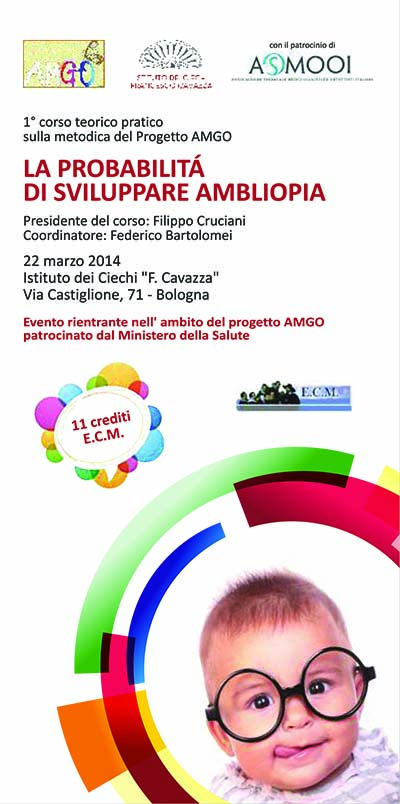On Saturday, March 22nd, 2014, project AMGO was held at the Great Hall of the Institute for the Blind Francesco Cavazza, consisting of the first theoretical and practical course on the method of screening amblyopia. The project, conducted by the Istituto Cavazza nationwide, has received the support of the Ministry of Health and aims to raise awareness of citizens and institutions on the importance of visual prevention relating to amblyopia.
Amblyopia, also called "lazy eye", consists in a reduced development of visual function in one or both eyes, and this occurs because of a visual defect present in early childhood, the period during which take place the development and maturation of the visual system.
 The most common causes of amblyopia are strabismus and refractive errors such as untreated hyperopia, astigmatism and myopia. The risk of developing amblyopia, due to an untreated eye condition, is present in the first 7-8 years of life, when plastic changes within the developing visual system occur. The diagnosis and treatment must therefore take place within this period of time in which the visual system is still susceptible to modifications and enhancements if treated properly. The prevalence of amblyopia varies according to statistics from 1.6 to 3.6% of the population, but if caught in time it is possible to fully recover. As mentioned, a delayed diagnosis may preclude the success of rehabilitation. It is therefore important to have your child seen by a specialist whenever you suspect visual problems. It is of primary importance to have the child see a specialist no later than after three years of age.
The most common causes of amblyopia are strabismus and refractive errors such as untreated hyperopia, astigmatism and myopia. The risk of developing amblyopia, due to an untreated eye condition, is present in the first 7-8 years of life, when plastic changes within the developing visual system occur. The diagnosis and treatment must therefore take place within this period of time in which the visual system is still susceptible to modifications and enhancements if treated properly. The prevalence of amblyopia varies according to statistics from 1.6 to 3.6% of the population, but if caught in time it is possible to fully recover. As mentioned, a delayed diagnosis may preclude the success of rehabilitation. It is therefore important to have your child seen by a specialist whenever you suspect visual problems. It is of primary importance to have the child see a specialist no later than after three years of age.
Today, thanks to technological innovation, the tools available to the orthoptist and ophthalmologist give them the opportunity to evaluate with yet more precision children even at an early age. The methodology used in the AMGO project allows people to have their children screened as young as age one. During the session, participants came from all over Italy to the Istituto Cavazza and they were able to listen to conferences given by various experts, and participate in orthoptic screening that involved on this occasion two districts of the City of Bologna: the Santo Stefano and San Vitale neighbourhoods. The hope is that those who have had this experience could share it in order to contribute to the early treatment of the disease which is fully avoidable through prevention.




.png)